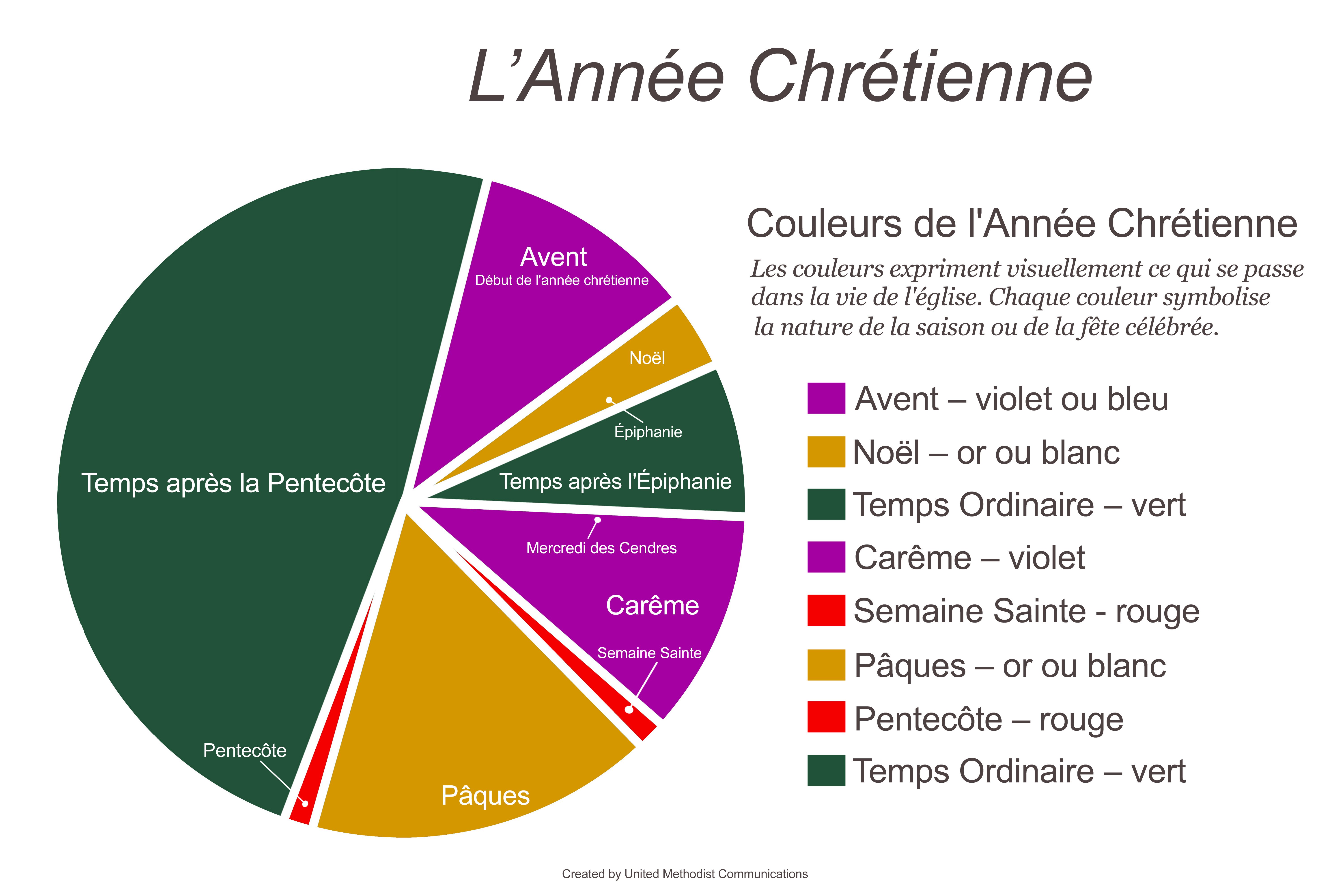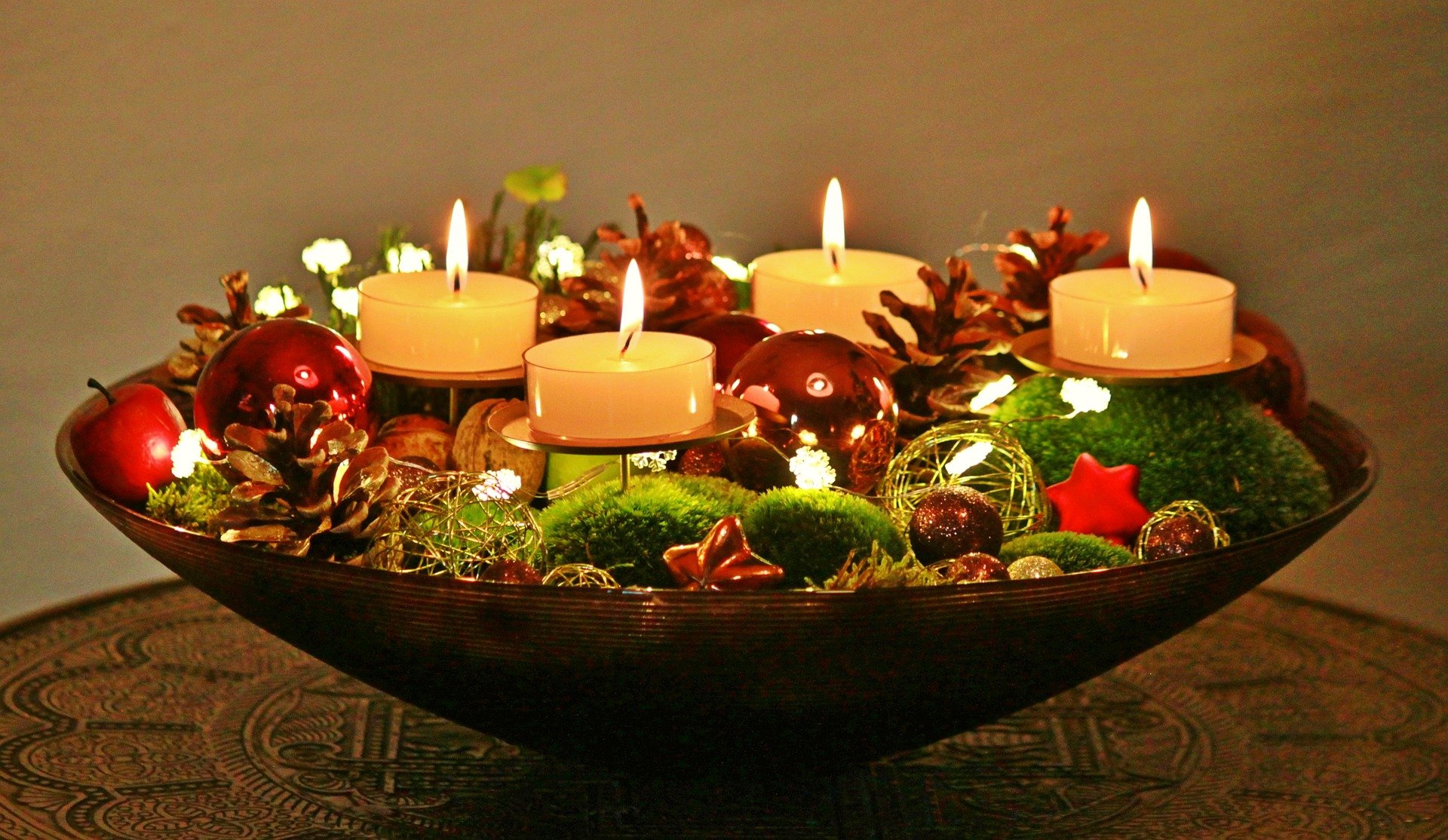Just as the seasons of the natural year – winter, spring, summer, fall – cycle in a familiar routine, many cultures develop annual calendars with days and seasons of meaning. The Christian church is no different, having developed a “liturgical calendar” in the earliest days of the church. Rooted in a calendar of religious events kept by the Jews even longer, the Christian liturgical calendar is loosely linked with the seasons of our world, and is specifically intended to annually walk the faithful through the birth, life, death, and resurrection of Jesus Christ.
There are two primary “cycles” to the Christian year: The Christmas Cycle (Advent – Christmas – Epiphany) and the Easter Cycle (Lent – Easter – Pentecost), with a season of “ordinary” time (named not because it is mundane, but because the Sundays are counted, or ordered, by ordinal numbers, eg. Third Sunday after Epiphany, as opposed to First Sunday of Lent).
Because part of the intent of the liturgical year is to help nurture faith, for every Sunday within each season there are assigned readings from the Bible. Collected in what is called the Common Lectionary, each reading is a selection (or “lection”) of Scripture generally related to the season or holy day. For each Sunday there are four passages, usually one from the Old Testament (Hebrew Scriptures), one from the Psalms, one from the Gospels, and one from the New Testament letters or Revelation. In certain seasons and for certain holy days the lections have been chosen with an eye to common theme, in all four readings if possible but definitely in the gospel lections, as noted below.
While there are some differences in the Christian liturgical year, especially between western Christianity and eastern Christianity, here is how it is marked in many of our United Methodist Churches:

The Christmas Cycle
The Christian calendar begins with the Season of ADVENT, a time of four Sundays before Christmas (set as December 25th in the year 336). This season is about hope and preparation, anticipation and fulfillment. The liturgical readings – those Scripture passages assigned to particular days – of Advent bounce back and forth between the prophets’ and Jews’ anticipation of a coming Messiah, and Christians’ anticipation of Christ’s return. In highly liturgic churches, the focus of the season begins in penitence, recognizing and confessing our sin in anticipation of the second coming of Christ.
- The liturgical color for the season of Advent may be either purple, which both connotes royalty for the coming of a king and is traditionally used in Christian churches as a sign of penitence, or dark blue, reminiscent both of the dawn of creation and of birth. Purple is noted more for solemnity and somberness, while blue is viewed as symbolizing hopefulness. (And if you wonder why a pink candle is sometimes but not always included in advent wreaths, the pink candle was introduced to be used for the third Sunday to mark that one is more than halfway through the season, and the focus on penitence prior to the return of Christ can shift to more of celebration for his arrival.)
- Lectionary readings for Advent include selections from the prophets about the promise of a Messiah, Gospel readings related to Christ’s return and/or about John the Baptist, and some celebratory passages both from Psalms and also Mary’s “magnificat” from Luke.
There is a tension between our Christian calendar and our cultural celebrations of Christmas. In the Church, technically the weeks leading up to Christmas are not the Christmas season. That is why some clergy and churches insist that they will not sing Christmas carols or songs until Christmas Eve services mark the end of the Advent season, and instead focus on lesser known Advent carols.
“No Christmas songs until after Advent!”
-Curmudgeonly church pastors nationwide
Culturally, though, it seems that the day after Thanksgiving (if not before!) families are focused upon the holiday, putting up their lights and decorations, purchasing presents, and preparing for family get-togethers. Like other tensions that exist in the church, I’ve seen leaders and congregations go in two different directions. One is to be believer-focused, and insist on following rigid rules that perpetuate the Advent season as it has always been celebrated, thus the readings in local churches in this season focus upon apocalypse and John the Baptist and, frankly, baffle visitors thinking it is Christmastime. Other churches lean in the direction of being seeker-friendly, and they bring the Christmas story to life in different ways throughout the Advent season (there are even modified versions of the lectionary that now shift the Advent season back two to three weeks, allowing for their liturgical function for believers, and then introduce more familiar Christmas-related stories in the lead up to Christmas Eve). Like many other tensions and conflicts in the church, neither of these approaches is necessarily more “right” than the other, but some do tend to get fiercely protective of them!
The Season of CHRISTMAS begins on December 25th and continues for 12 days, ending on January 6 (EPIPHANY); so whenever you hear about the “twelve days of Christmas,” they are actually referencing this season! The Christmas Season ends with the Day of Epiphany, the day noting the visit of the wise men to the baby/toddler Jesus in Bethlehem. The day is celebrated as the “manifestation” of Christ to Gentiles, and as Biblical theophanies are so often described it is associated with light, particularly the light of the star that guided the wise men.
- As a “high holy day,” the colors for Christmas Eve and Christmas Day in particular, but by extension the entire (short) season, are white and gold. These colors may be used on other specific holidays (including Easter), and symbolize festive celebration, purity of soul, and even death and resurrection. Other days that use white, in particular, include the Sundays of: Epiphany, Baptism of the Lord, Transfiguration, Easter, Trinity Sunday, and Christ the King Sunday.
- The lectionary readings for Christmas and Epiphany focus upon Jesus’ early years as well as God’s relationship with Gentiles (non-Jews).
A short “ordinary” time follows Epiphany, which is January 6. Also called “Three Kings Day,” this feast day is celebrated with a variety of traditions in some western cultures, especially those of hispanic connections. One Sunday around this time generally marks the baptism of Jesus by John the Baptist.
- The Sundays of ordinary time are marked with the color green, for growth. Part of the intent of the liturgical cycle is to help disciples grow in their knowledge, love, and faith in God.
- During the two “ordinary” seasons, the liturgical Old Testament readings tend to focus upon the stories in the Torah (the first five books of the Old Testament) while the New Testament readings tend to focus upon the life and teachings of Jesus Christ.
The Easter Cycle
LENT is a season and traditionally a fasting period of forty days (plus seven Sundays that are not included in the fast) that begins on Ash Wednesday and ends with the dawn of Easter Sunday. Ash Wednesday starts the season, using the biblical notion of ashes for repentance to ground the beginning of a season that focuses upon penitence and spiritual practice. The great “Tridium” occurs during Holy Week, beginning at sunset on Maundy Thursday (the evening Jesus washed the disciples’ feet, celebrated the passover with them and instituted what we know of as communion, and was arrested in the garden) and continuing through Good Friday (the day he was crucified) and into the dawn of Easter Sunday (the day of resurrection!).
- The color for Lent is purple, as noted above in the conversation of Advent colors, for its connection both to royalty and penitence.
- Lent lectionary readings tend to focus upon human sin and repentance, as well as Jesus’ journey to the cross.
The Season of EASTER, with its white color, includes a total of 7 Sundays beginning with Easter Sunday (which is determined by the lunar calendar and so shifts between late-March and mid-April), marking the time that Jesus appeared to his disciples after his resurrection. The first Sunday after the Easter Season, PENTECOST Sunday, focuses upon the anointing of the disciples’ by the Holy Spirit after Jesus’ resurrection. After Pentecost, the liturgical calendar enters the longer season of “ordinary” time with two noted holy days: the Sunday after Pentecost is TRINITY SUNDAY, commemorating the Christian doctrine of the Trinity, and the last Sunday of the liturgical year (the Sunday before Advent) is CHRIST THE KING SUNDAY, marking the sovereignty of God and Christ and the Christian’s subsequent allegiance to Jesus.
- As noted above, Easter and its 7 Sundays are marked with the colors of white and gold.
- Easter lectionary readings focus upon the resurrection and appearances of Christ and the early churches experience as remembered in The Acts of the Apostles.
- Pentecost is marked by the color red in recognition of the coming of the Holy Spirit, and is the only day in most mainline churches that significantly uses the color red (other churches use the color on the feast days of martyrs and for some other holy days).
- *Liturgical readings for Pentecost focus on the Holy Spirit, for Trinity Sunday teach about our Trinitarian faith, and for Christ the King focus upon the sovereignty of God and Christ
